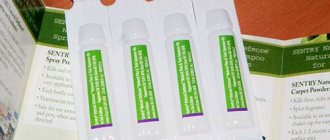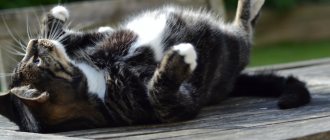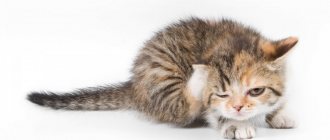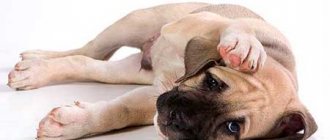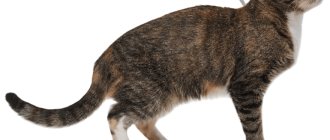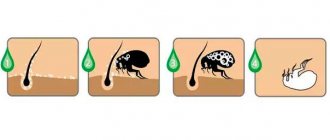Fleas are blood-sucking parasites that are easily transmitted from animal to animal. To combat these insects, pet stores and veterinary pharmacies offer many drugs, however, it is flea drops for cats that have gained well-deserved popularity. They act quickly, are easy to apply and are also considered a universal remedy that is widely used as an antiparasitic complex agent.
Find out what signs you can use to determine if a cat has fleas, and why they are dangerous>>>
Methods of flea infestation
Most often, an animal becomes infected on the street, but even a domestic cat that has never left the apartment and has not been in contact with sick animals can become a victim of blood-sucking insects.
The main factor is the presence of eggs laid by fleas, which the owner himself can bring into the house, for example, on the sole of a shoe.
Close-up view of a flea.
The principle of action of the drugs
Flea drops act exclusively on the animal’s skin and do not enter the bloodstream. After you have dropped the drug on your pet, you will not be required to take any additional action. The main active ingredients of the drops are themselves distributed over the skin, hair follicles and fur of the animal. These drugs act as neurotoxins on fleas.
The parasites are simply paralyzed and the fleas soon die. In general, fleas should die within a maximum of 24 hours after applying the drops. Bathing your pet can interfere with this; the drug will simply be washed off with water, so keep your pet away from water for 48 hours after use. And keep your pet away from children, the chemicals may harm the child.
Pros and cons of using drops
In veterinary medicine, such a flea remedy as drops is common. Their advantages:
- ease of use;
- versatility - the drops additionally protect the cat from ticks, lice, lice and helminths;
- effectiveness - repeated prophylaxis should be carried out after 2-3 months (for each drug, the duration of action is indicated in the instructions).
Disadvantages of drops:
- most products are contraindicated in kittens under 12 weeks of age and pregnant cats;
- toxicity - at least 2-3 days must pass from the last bath of the animal until treatment with drops, so that a protective fat layer has time to form.
Applying drops to the cat's fur.
In what cases do veterinarians recommend using drip medications?
Drops against fleas, ticks and worms for cats are the most effective and safe means for getting rid of parasites and preventing their occurrence. Thanks to this form, they are quickly absorbed into the skin of furry pets and evenly distributed throughout the body. After consuming blood with an insecticide, fleas will die within 24 hours, and the protective effect after their use will last at least a month. In addition, the drops can be applied precisely to those places where the animal definitely cannot reach and lick the drug. Among the existing drops against fleas and ticks for cats, each owner will be able to choose an option that is acceptable for him and his pet - effective, cheap, safe.
Veterinarians do not recommend using drops against fleas and other external parasites for the following categories of pet cats:
- kittens under 2 months old;
- cats during pregnancy and lactation;
- sick, weakened and recovering pets.
Drops are the best flea remedy for cats that often walk outside, as well as for very active pets that cannot sit quietly for even a couple of minutes. Anti-flea preparations in this form are perfect for both long-haired and short-haired pets.
At what age are flea drops used?
Almost all drugs are intended for cats aged 2-3 months, but there are also safe drops that can be used for treatment earlier.
Some cat drops suitable for pregnant and lactating cats are contraindicated for kittens. Therefore, to avoid harming the animal, read the package insert.
Frequency of treatment of kittens
To prevent the appearance of fleas, prevention is required once a quarter. If a kitten is infested with fleas, it should be treated with antiparasitic medication immediately.
Effective drops work instantly, killing blood-sucking insects from the first minutes of contact with the pet’s body.
Rules for handling pets
Before using drops, you must read the instructions for their use. The instructions contain information about indications, contraindications and precautions.
It is important to apply the drops not to the fur, but to dry skin without damage. Application area: near the back of the head (withers).
Standard rules for handling domestic cats:
- When applying the medicine, do not allow it to come into contact with the skin.
- After treating the animal, even if the drug was in ampoules, wash your hands thoroughly.
- In order to achieve maximum effect and be able to quickly identify adverse reactions, the kitten should be supervised for the first 2-3 hours.
- If your pet must be left alone, put a veterinary cone on him.
Methods of applying the drug.
Precautionary measures
The peak of toxicity, when the drops act, occurs on the first day. Therefore, it is forbidden to pet the animal and allow it near children.
If a treated cat accidentally comes into contact with human skin, rinse the area with plenty of water. Avoid contact with mucous membranes and affected areas of the skin.
Contraindications and side effects
The only absolute contraindication to the use of anti-flea drops is the cat’s individual intolerance to the components of the drug. Veterinarians recommend carrying out the following test before application: drop a little product on the withers and observe the pet for 24 hours. If after this time no redness or swelling has appeared, and the animal’s well-being has not worsened, then you can safely begin flea treatment.
Owners should not give cats multiple flea medications at the same time. In this case, the pet may experience an overdose, which poses a great threat to its life and health.
Owners should also carefully study the composition of anti-flea drops before treating their cat. Permethrin products paralyze and kill fleas, but can also kill a cat. Previously, products containing this substance were widely used to treat animals. However, according to recent research by scientists, they are very toxic to cats not only when ingested, but also when applied to the skin, and, on the contrary, are harmless to dogs. That is why manufacturers now include permethrin exclusively in anti-flea drops for dogs. Unfortunately, some owners think that the organisms of these animals are similar, so they treat their cats with flea products for dogs, which can lead to irreparable consequences.
Contraindications to the use of most anti-flea drops in cats may include:
- pregnancy;
- lactation;
- age up to 2 months;
- too little weight;
- feeling unwell due to illness.
In addition, you cannot treat a cat for fleas if it has had surgery and less than 3 weeks have passed since the stitches were removed.
If the instructions for use are not followed, the cat may experience various side effects after applying flea drops:
- dyspnea;
- vomit;
- diarrhea;
- muscle tremors;
- increased salivation;
- lacrimation;
- itching
Important! If any side effect occurs, wash off the drug and immediately show the cat to a veterinarian.
How long before you can wash after applying drops?
The period before washing a cat after flea treatment depends on the composition of the product used. It takes 1-2 days for a water-based product to absorb, and about 5 days for an oil-based product.
If you notice allergy symptoms (itching, redness, fresh scratching), your cat should be bathed immediately. A local reaction to the use of the drug can cause irreversible consequences that will require urgent treatment of the animal.
In order not to harm the cat and to be sure that the necessary protective layer has been formed, it is recommended to use the drops 2-3 days after bathing. In some cases, this period is 5 days.
Contraindications for use
Any medicine has its contraindications and flea drops are no exception. Most medications can only be used on pets older than 12 weeks. For a very small kitten, it is better to replace the droplets with a special shampoo, combing out fleas, or using traditional methods.
Almost every instruction contains restrictions for use by pregnant and lactating cats. Also, in order to avoid side effects, you should not use drops on weakened and exhausted cats. But the main contraindication is individual intolerance to the components.
What happens to fleas after treatment?
Drops have a detrimental effect on parasites in one of three ways:
- Impact on the nervous system, resulting in death.
- Contact action. A toxic substance with a poisonous effect penetrates the insect’s body through direct contact.
- Repellent effect. The smell of some products can only repel fleas, but will not lead to their destruction.
Protection from parasites.
Side effects
Flea drops are not highly toxic, and if you notice that your pet has licked a little of the drug, there is no need to worry. Nothing serious will happen. For prevention, you can rinse your tongue and mouth with running water. However, if you did not follow the rules of application, and the cat licked large quantities of flea drops, the following side effects may occur:
- itching;
- allergic reaction;
- shiver;
- weakness;
- refusal of food;
- vomit;
- weight loss;
- temperature;
- lacrimation;
- severe salivation (sometimes until foam appears).
Your actions in case of poisoning must be immediate. For the first two days, you need to give your pet warm water and liquid food. Immediately after side effects appear, the animal should be bathed in warm water with shampoo, wiped dry and create comfortable conditions for rest. If drops get on the mucous membranes of the eyes or mouth during treatment, rinse the damaged area with boiled water.
In the event that symptoms of poisoning last more than two days, self-medication should be stopped and professional help should be sought.
What to do if drops don’t help
Flea medications may not be effective in the following situations:
- The medicine was chosen incorrectly.
- Application rules not followed.
- The dosage was calculated incorrectly.
- The date of preventative treatment has been missed.
- The drug is used after the expiration date.
If you have treated your cat according to the instructions, but there is no effect, contact a veterinary clinic for help.
Veterinarian help.
Instructions for use
Flea and tick control drops for cats are very easy to use. No special preparation is required before using such drugs - just not bathe your pet for 2-3 days before and after treatment. In addition, if there are several pets living in the house, they all also need to be treated with a medicine against fleas and other parasites.
Important! Applying flea and tick medications for cats is only allowed on dry and intact skin in places inaccessible to licking. Otherwise, various side effects may occur.
It is important to follow a certain procedure in order to drip the drug correctly:
- Place your pet on its stomach, caress and calm it down.
- Hold the cat firmly, while spreading the fur on the back of the head or withers.
- Apply drops in a dosage that corresponds to weight and age. Do not rub.
The best drops and their characteristics
There are a lot of medications presented in the form of drops, which can be used against parasites. When choosing drops, you need to focus on parameters such as the animal’s age, weight, and general health.
For a kitten or female during pregnancy, you should choose the safest medicine possible.
As for effective means, the following have pronounced properties:
- Advantage. A highly effective product that should be used to treat adults and adolescents. To obtain a positive effect, you need to apply the contents of one package to the withers. This is enough to permanently rid the animal of parasites and symptoms that are caused by flea infestation.
- Frontline. This brand is represented by a wide range of medicines designed to combat skin parasites, including fleas. To choose the best option, it is recommended to first consult with a veterinarian. This medicine has one interesting feature, which is that the animal's fur may change color slightly. Accordingly, it is not recommended to handle your pet shortly before exhibitions.
- Bifar. One of the most effective potent remedies that will help rid a cat of fleas even against the background of a severe parasitic infestation. Due to the high toxicity of the components used to make this medicine, it is strictly not recommended to use it to treat nursing, pregnant cats, and kittens. Before use, it is important to make sure that the animal is not sick and is feeling well. The death of parasites occurs no later than within 24 hours after application of the drug.
- Inspector. The medicine is presented in the form of a solution, which should be applied to clean and dry skin of the animal’s withers. To eliminate the possibility of reappearance of parasites, it is important to avoid bathing your pet for four days after the procedure. This medicine can be used for the treatment and prevention of flea infestation, which is due to its rather mild effect. But you should not abuse the medicine.
- Celandine. Contrary to popular belief, which is completely wrong, this drug is made on the basis of toxic chemical components and has nothing to do with the plant. Having a similar name. This drug is the most popular on the modern market; it can be used to treat adults and kittens. The duration of action is from one and a half to two months. To obtain a positive effect, it is recommended to bathe the animal shortly before applying the medicine. The drops should be applied exactly to the withers area; drops should be avoided getting into the animal’s digestive tract.
We should also talk about drops that can be used to treat lactating females, since parasitic infestation can cause them a lot of problems and also cause infection in their offspring.
To eliminate skin blood-sucking insects, in such cases, medications that have a mild, delicate effect are used.
They do not penetrate into the deep layers of the skin, but remain on their surface. It should be noted that drops of this kind mainly repel fleas and do not have a destructive effect on them.
When treating pregnant or lactating cats, special care should be taken, since licking a toxic substance by an animal can lead to extremely negative consequences, including for offspring.
If the cat's condition worsens precisely after using the drops, you should immediately show it to a specialist.



